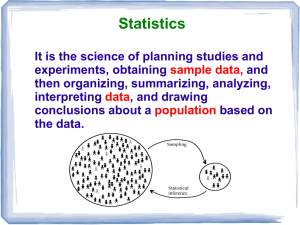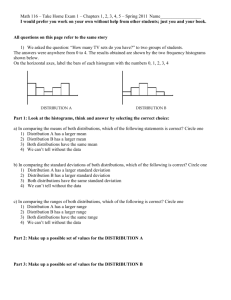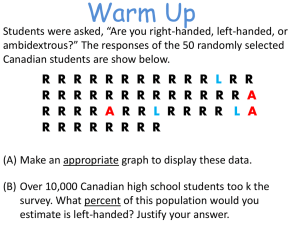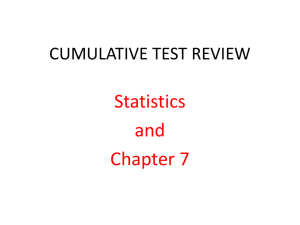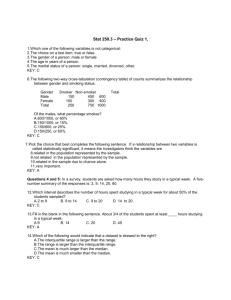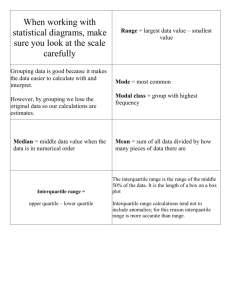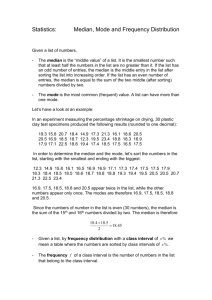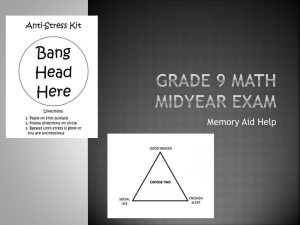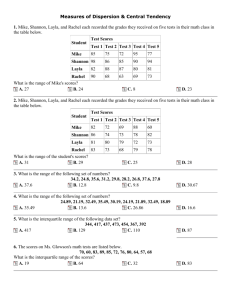Stats 1 Revision Cards
advertisement
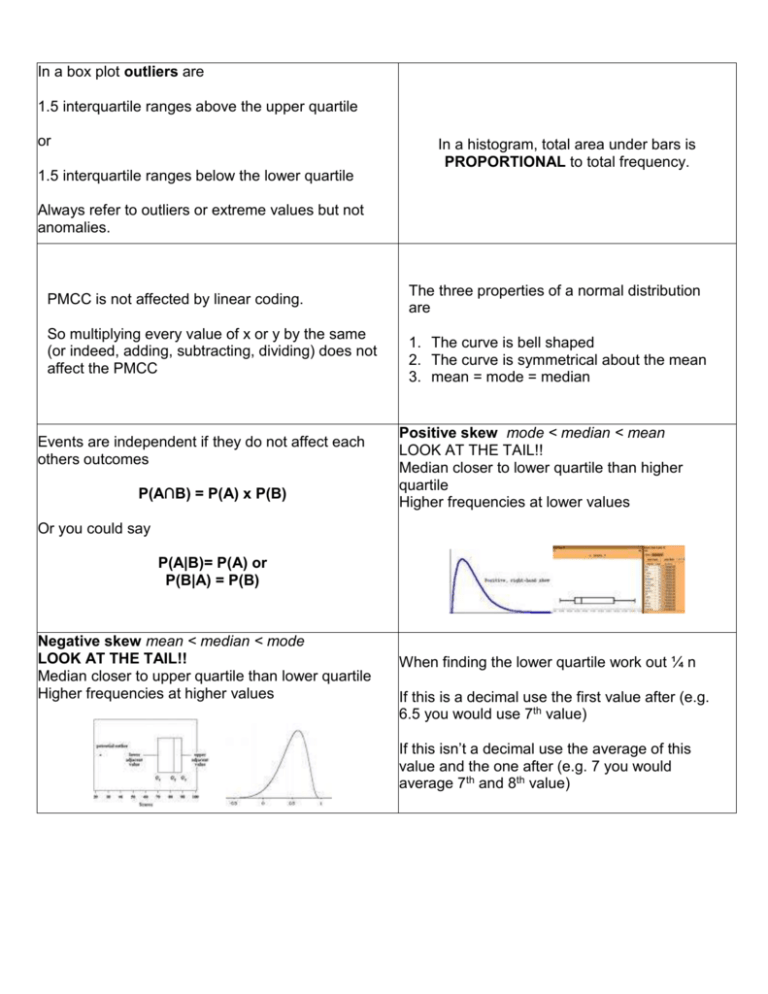
In a box plot outliers are 1.5 interquartile ranges above the upper quartile or 1.5 interquartile ranges below the lower quartile In a histogram, total area under bars is PROPORTIONAL to total frequency. Always refer to outliers or extreme values but not anomalies. PMCC is not affected by linear coding. So multiplying every value of x or y by the same (or indeed, adding, subtracting, dividing) does not affect the PMCC Events are independent if they do not affect each others outcomes P(A∩B) = P(A) x P(B) The three properties of a normal distribution are 1. The curve is bell shaped 2. The curve is symmetrical about the mean 3. mean = mode = median Positive skew mode < median < mean LOOK AT THE TAIL!! Median closer to lower quartile than higher quartile Higher frequencies at lower values Or you could say P(A|B)= P(A) or P(B|A) = P(B) Negative skew mean < median < mode LOOK AT THE TAIL!! Median closer to upper quartile than lower quartile Higher frequencies at higher values When finding the lower quartile work out ¼ n If this is a decimal use the first value after (e.g. 6.5 you would use 7th value) If this isn’t a decimal use the average of this value and the one after (e.g. 7 you would average 7th and 8th value) A statistical model is A statistical process to describe or make predictions about the expected bahaviour of a real-world problem Why use statistical models? Used to simplify or represent a real world problem Modelling: 7 steps! RDPECER Step 1: Recognise a real world problem Step 2: Devise a statistical model Step 3: model used to make Predictions Step 4: Experimental data is collected Step 5: Comparisons made against devised model Step 6: Evaluation: Statistical concepts used to test how well model describes real-world problem Step 7: Refine model If you are given E(X) then E(aX) = aE(X) E(aX + b) = aE(X) + b Cheaper or quicker or easier or more easily modified Example E(X) = 3 To improve understanding of the real world problem Then E(5X)= 15 Used to predict outcomes from a real world problem If you are given Var(X) then Var(aX) = a2Var(X) Var(aX + b) = a2Var(X) Example Var (X)= 4 Var (2X)= 22 x 4 = 16 Var (2X - 3)= 22 x 4 = 16 Var (3 - 2X)= (-2)2 x 4 = 16 E(7X+4)=25 In a stem and leaf diagram, put all leaves in order and remember the key! A title with what the diagram is showing is also helpful. Events are mutually exclusive if P( A | B) P( A B) P( B) P(something given something) = P(both)/ P(given) Use a histogram if the data is continuous, and if the data is grouped unevenly. P(A∩B) = 0 A and B cannot happen together Also can be written as P( A B) P( A) P( B) P( A B) If a distribution is skewed then it has extreme values Median/ Interquartile range better than mean/ standard deviation because they are not affected by outliers. However the mean takes into account all values! Normal distribution not suitable for modeling skewed distributions as it is symmetrical. Put your answer in context Positive correlation (not enough) Positive linear correlation (better) Strong positive linear correlation; as temperature increased so did number of ice creams sold (best) Mean = When talking about skew in a box plot look only at the box!! Standard deviation is x n x or xf n f A statistical experiment is a 2 x f f 2 mean or 2 mean 2 LEARN THIS process used for collecting data to provide evidence for or against a hypothesis Mean of squares – square of mean An event is It is not suitable to extrapolate (estimate using a line of best fit outside the range of data collected) as a linear relationship may not remain valid. one of the possible outcomes of an experiment Interpolation is more accurate but is A model will never be able to cater for all the eventualities of a real life problem dependent on how strong the correlation is (look at the PMCC) A residual is the vertical distance between a point on a scattergraph and a line of best fit! For normal distributions draw a diagram. If X ~ N(4, 9), find P(X<12). First we "standardise". The mean is 4 and is 3 (the square root of 9). (subtracting 4 and dividing each side of the inequality by 3) Standardise by taking away mean and dividing by standard deviation. When finding the upper quartile work out ¾ n If this is a decimal use the first value after (e.g. 6.5 you would use 7th value) If this isn’t a decimal use the average of this value and the one after (e.g. 7 you would average 7th and 8th value) = P(Z < 8/3)= (8/3) = (2.67) = 0.9962 Capital F just means the probability to the left of and inclusive! It is the cumulative probability. F(0.6) = P(X<0.6) When finding the median work out ½ n If this is a decimal use the first value after (e.g. 6.5 you would use 7th value) Always remember that F(LAST POSSIBLE VALUE) = 1 ( x 2) 2 for x = 0,1,2,3 then a 25 table would be e.g. if F(x) = If this isn’t a decimal use the average of this value and the one after (e.g. 7 you would average 7th and 8th value) Do the same for quartiles and percentiles x F(x) 0 4/25 1 9/25 2 16/25 3 1 Then a probability distribution would be x 0 1 2 3 p 4/25 5/25= 1/5 7/25 9/25 A MEASURE OF SKEWNESS IS 3(MEAN – MEDIAN)/STANDARD DEVIATION All lines of best fit must go through the mean POSITIVE- POSITIVE SKEW NEGATIVE- NEGATIVE SKEW If possible draw a venn diagram to help you! REMEMBER THE BOX. The Normal distribution is continuous so you can’t do P(X = a) as this would be ineligible. For example P(X < a) = P(X < a) A discrete uniform distribution is a probability distribution with the same probability of all outcomes occurring e.g rolling a fair die The assumption that all probabilities are equal is If in a venn diagram, you are given that something has occurred, look only at the appropriate circle. Useful in theory – allows problems to be modelled However it is not necessarily true in practice To refine the model you would carry out an experiment to establish probabilities Be prepared to interpret the gradient and y intercept of a regression line IN CONTEXT The explanatory variable is the variable you start with (the one you control) e.g. if we are talking x axis – years employed by company y axis –salary The response variable is the variable which occurs as a result of the behaviour of the explanatory variable. Then gradient would be salary increase per year y intercept would be starting salary x p Only use a regression line is the PMCC shows strong correlation , as this shows the data can be modeled by a straight line. > +0.7 < -0.7 -1 0.3 0 0.2 1 0.2 2 0.2 3 0.1 Mean=E(X)= xp (1 0.3) (0 0.2) (1 0.2) (2 0.2) (3 0.1) = -0.3+0.2+0.4+0.3=0.6 Variance = E(X2) – (E(X))2= x 2 p mean2 = (1) 2 0.3 (0 2 0.2) (12 0.2) (2 2 0.2) (32 0.1) 0.6 2 = 0.3+0.2+0.8+0.9-0.36=1.84 Some features of a box plot are To work out E(X2) just do the first bit of the variance formula x 2 p 1. 2. 3. 4. 5. Allows comparisons Shows outliers Indicates spread/range/IQR Shows max/min/median/quartiles Shows skewness Don’t round until the end; never use a rounded value in calculations When using formulae, show your substitutions carefully This will lose you marks THIS WILL GET YOU MARKS FOR WORKING Stem and leaf can also be used to show skewness On a box plot High frequency at lower values POSITIVE SKEW Label axes and scale (ie values) High frequency at high values NEGATIVE SKEW A GOOD WAY TO SUMMARISE 2 SETS OF DATA IN ONE DIAGRAM IS A BACK TO BACK STEM AND LEAF AS IT ALLOWS COMPARISON. Coding does affect mean and standard deviation Multiplying all values by 3 would increase standard deviation by x 3 and mean x 3 Dividing all values by 3 would divide mean and standard deviation by 3 Adding or subtracting 3 would add or subtract 3 to the mean but would not affect the standard deviation If you are asked to work out a complex probability, THINK!! List outcomes or sketch a tree diagram. Can the situation happen in more than one way?
